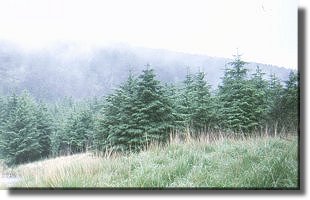Case Study 2: Lake acidification (Nilssen & Sandoy 1990).
The use of cladoceran remains to reconstruct acidification is relatively more difficult than in the case of a eutrophication scenario. The changes in species abundance and composition over small pH ranges can be difficult to detect and demand a thorough knowledge of the ecology of the animals involved in the change.
Changes in cladoceran composition have been associated with acidification, but most of these observations can be related to predation and vegetation changes and thus only indirectly related to varying pH. In some cases the components of the planktonic communities have been shown to be better pH indicators than the littoral communities.
 Acid Rain |
The major processes that affect animals in acidified lakes change physiological, competitive and predatory interactions. Habitat structure may also be altered.
Pelagic taxa (e.g. fish and daphnids) are physiologically vulnerable to increased acidification. Below 5.2-5.5 fish have problems with reproduction and populations decrease. In contrast important invertebrate predators (e.g. copepods and corixids) in the littoral and pelagic zones often increase with acidification. The change in predation pressure may be reflected in changing species composition, community structure and morphological adaptations.
Under acidified conditions there may be an increase in periphyton growth and the expansion of Sphagnum spp. and Juncus bulbosus leading to an increase in total plant biomass and the alteration of the physical structure of the habitat. The creation of these new microhabitats will alter the inter species competitive balances and may allow larger populations of littoral-benthic species to develop.
Conversely the decreasing macrophytes may not be replaced by new plant species and there will be fewer microhabitats and the total species diversity will decrease. The nature of benthic substrate will change from soft mud and vegetation debris to coarser mud, resulting in a change in species composition.
In general species number and diversity in the planktonic community decrease with decreasing pH, but the littoral-benthic community diversity may decrease, remain stable or even increase depending upon the habitat changes. The best pH indicators are the genus Daphnia and Bosmina longirostris (decrease or disappear at low pH) and Acantholeberis curvirostris (increases at low pH). Other indicator species are: Alona intermedia, A. quadrangularis, A. guttata, Alonella exigua, Ophryoxus gracilis, Ceriodaphnia quadrangula, Bythotrephes longimanus, Leptodora kindtii (usually decreasing with acidification) and Alona rustica, Alonella excisa (usually increasing with acidification).
Gulspettvann Core
The critical interval of pH change for cladoceran communities is pH 6.0
to pH 5.0 and such a change has been indicated by diatom analysis for
this core. The plankton community showed a disappearance of the acid-sensitive
D. longispina, B. longimanus, L. kindtii and B.
longirostris. The littoral species showed a disappearance of A.
intermedia, A. exigua, A. guttata and Ophryoxus gracilis.
PALAEOLIMNOLOGY | EUTROPHICATION | CLIMATE CHANGE
TAXONOMY | MORPHOLOGY | LIFECYCLE
WATER CHEMISTRY | HABITATS | PREDATION